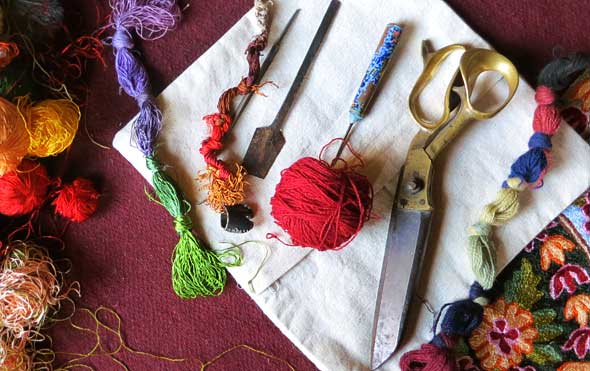Origin
In India,we have different states with their rich and diverse handicrafts.Each of them have their unique style and aesthetic appeal.One such embroidery style is ‘Aari‘ which is also known as ‘khatla work’ or ‘mochi’ embroidery. Aari embroidery originated in the Mughal era and is predominantly practiced in the Kuthch regions of Gujarat and Kashmir. Muthia which is a sharp edged needle with a hook and threads are the main tools used to create this intricate and delicate hand work.

Inspiration
Taking its roots back to the 12th century during the Mughal era,this intricate form of embroidery draws its inspiration from the elements of nature. Foliage motifs and patterns;birds and animal designs can be seen in this handwork.
Creation of Art
The fabric is tightly stretched over a wooden framed cot or ‘khatla’ to make it firm and remove any crease.This helps the artisans to create the intrinsic designs with ease. The designs are drawn on a tracing paper with lead pencil and holes are pierced along the lines of the design.The paper is then placed over the stretched fabric and smeared with blue ink which seeps through the holes and creates an outline on the fabric. With the use of Aari (the hook like needle) colorful threads and zari are used in creating the exquisite patterns.The prick and pounce method is implemented to create these chain stitches.

Tools used
The crochet hook like needle, threads including cotton,silk and zari are extensively used in the creation of aari embroidery. Stones, beads, dabka, sequins etc are incorporated by the artisans to create vibrant and vivid patterns.

Aari in Clothing
Since time immemorial aari embroidery has been extensively used to adorn leather shoes and garments. Its significance has attained a global appeal. We can take pride in saying that elegance and uniqueness of our Indian hand embroidery has attracted the westerners too. It has been admired and appreciated by women of all age groups. Needless to say, not only has aari been used to beautify sarees, kurtas,dupattas and lehengas, however we have adopted this embroidery in home decor as well.
References
https://strandofsilk.com/journey-map/gujarat/aari-embroidery/motifs-and-colours
https://rabikablog.wordpress.com/2017/10/20/introduction-to-aari-work/
https://www.unnatisilks.com/blog/aari-embroidery-fine-tradition-exquisite-art/
